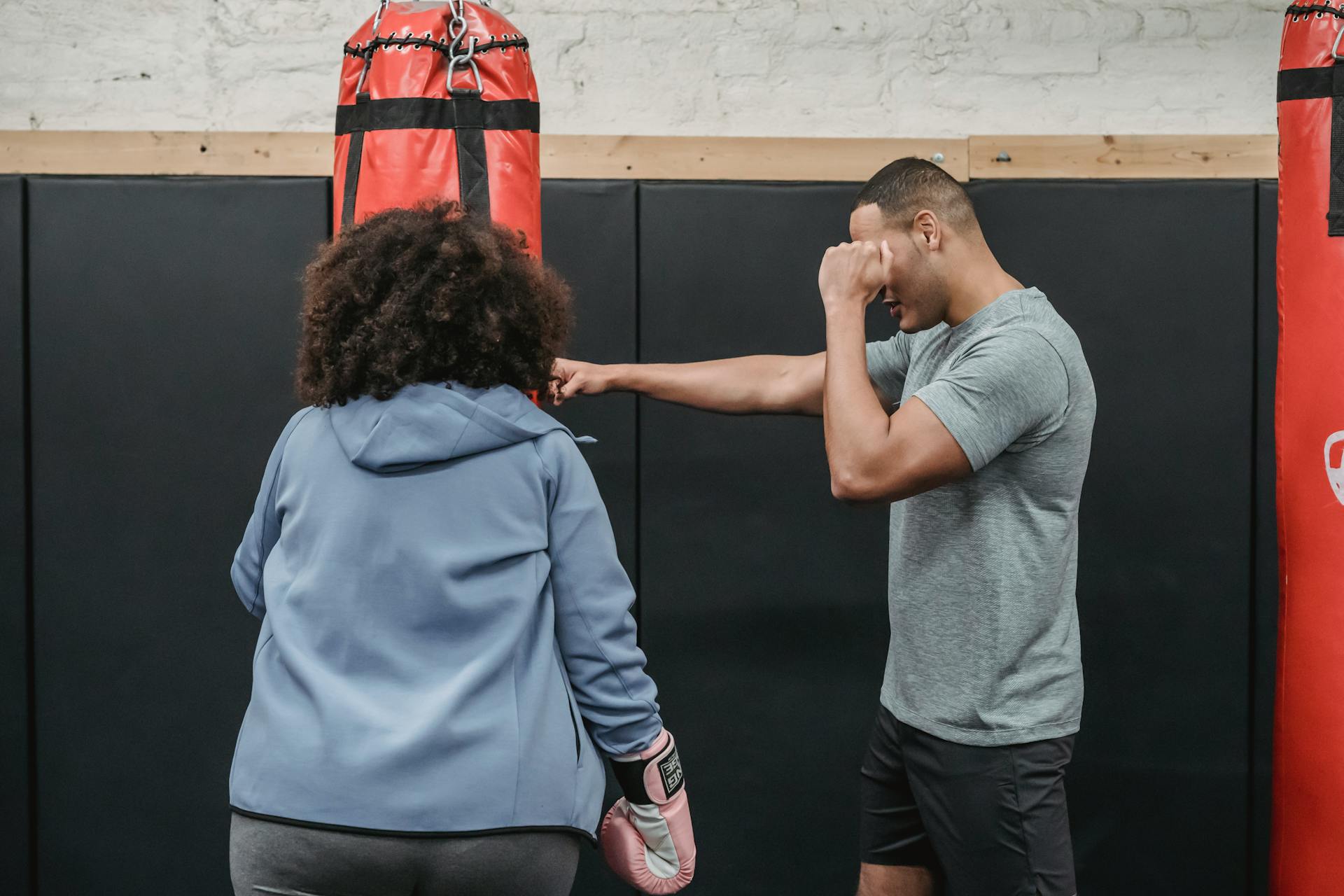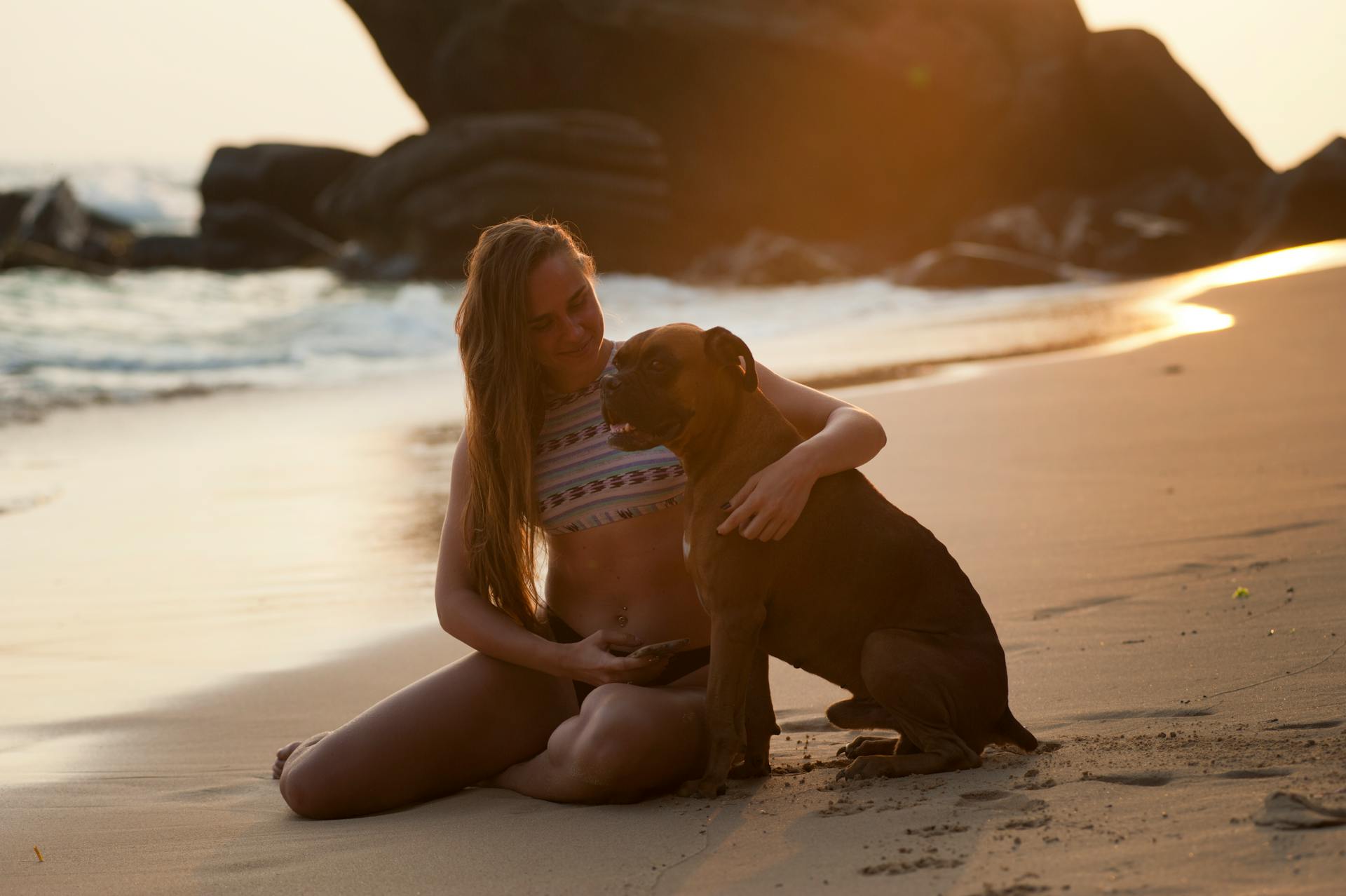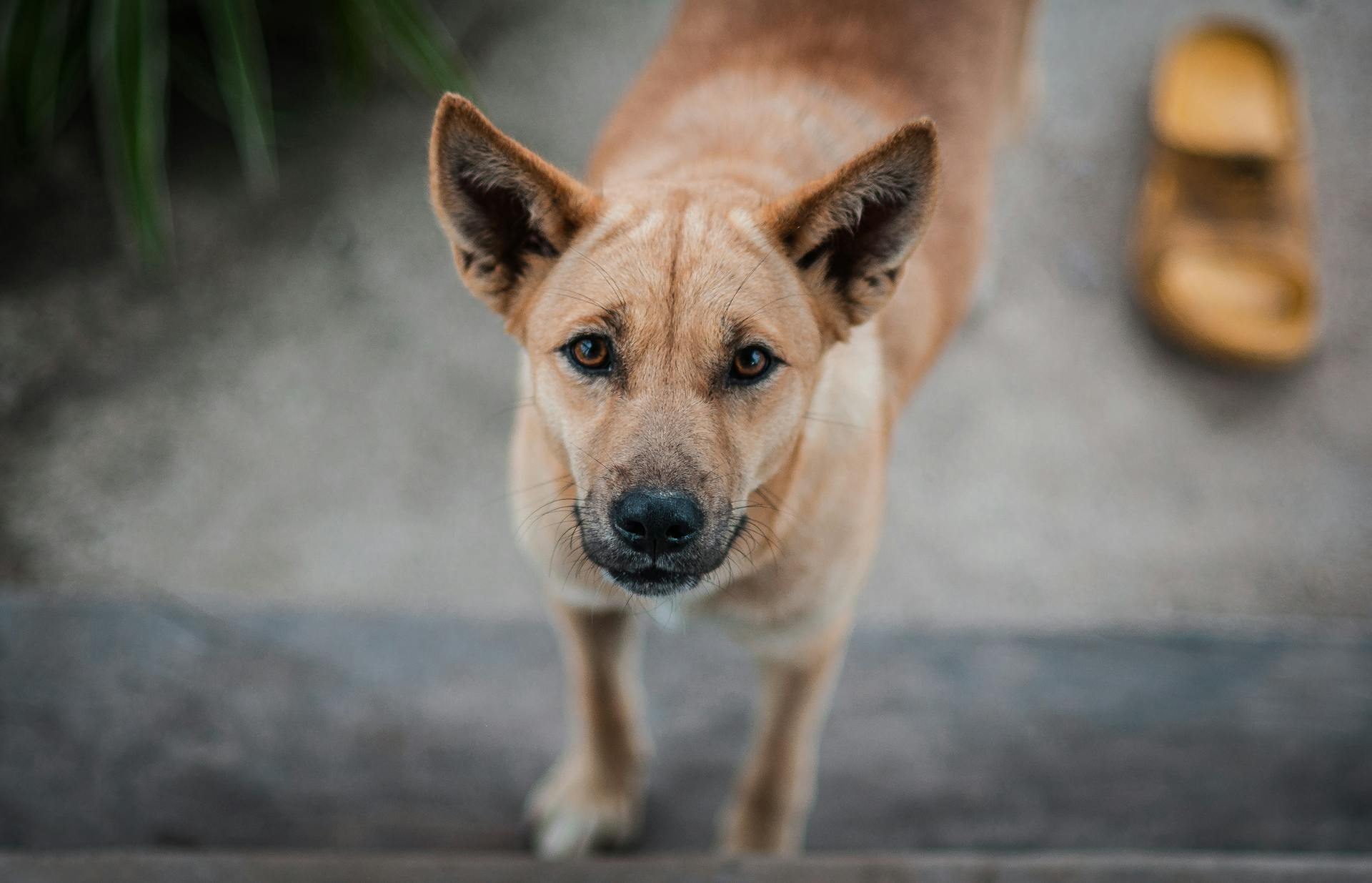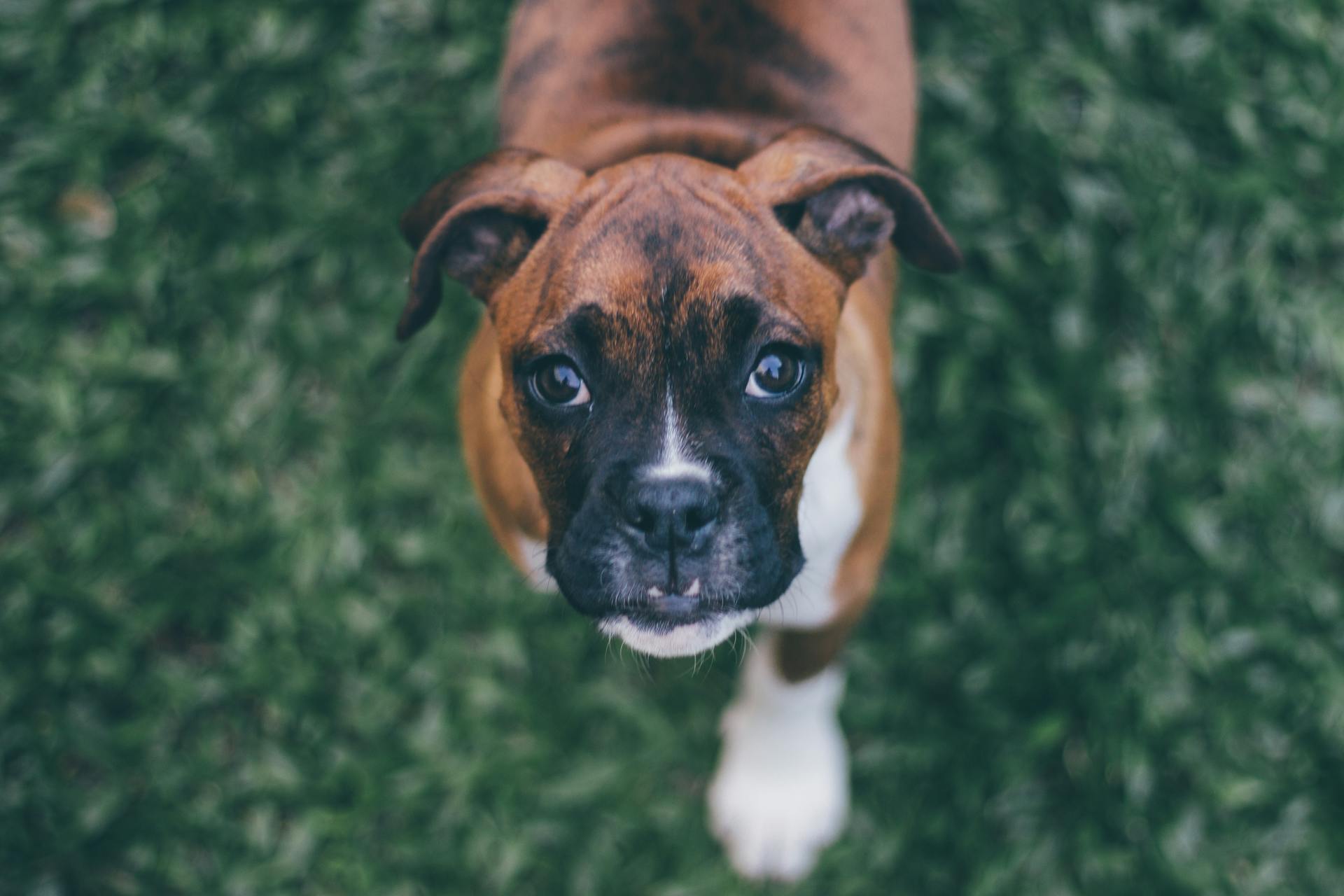
The Boxer breed standard is a set of guidelines that outlines the ideal characteristics of a Boxer dog. The breed standard emphasizes the importance of a Boxer's physical appearance, temperament, and movement.
A Boxer's muzzle should be broad and deep, with a well-defined stop and a black mask. The breed standard also specifies that the eyes should be dark brown and full of expression.
In terms of size, Boxers typically weigh between 60-70 pounds and stand between 21.5-25 inches tall at the shoulder.
Physical Characteristics
The head is the most distinctive feature of the Boxer, with the breed standard dictating that it must be in perfect proportion to the body.
A Boxer's muzzle should be of correct form and in absolute proportion to the skull, with a ratio of 1:3 in length to the whole of the head.
Folds are always present from the root of the nose running downwards on both sides of the muzzle.
The tip of the nose should lie somewhat higher than the root of the muzzle.
A Boxer should be slightly prognathous, meaning the lower jaw should protrude beyond the upper jaw and bend slightly upwards in an underbite or "undershot bite".
The breed standard also dictates that the muzzle should never be too light.
Breed Overview
The Boxer breed standard is a unique and fascinating topic. The Boxer is a medium-sized dog with a muscular build, weighing between 60-70 pounds.
Their short, smooth coat requires minimal grooming, making them a great choice for busy owners. This breed is known for its distinctive "mask" of black fur around the eyes, which is a key characteristic of the breed.
Boxers are known for their playful, energetic personalities, and they require regular exercise to stay happy and healthy.
History
The Boxer breed has a rich history that spans centuries. Developed in Germany in the late 19th century from the Bullenbeisser and Bulldogs, the Boxer was originally bred for hunting.
The Bullenbeisser had been working as a hunting dog for centuries, employed in the pursuit of bear, wild boar, and deer. Its task was to seize the prey and hold it until the hunters arrived.
In 1894, three Germans, Friedrich Robert, Elard König, and R. Höpner, decided to stabilize the breed and put it on exhibition at a dog show. They founded the first Boxer Club, the Deutscher Boxer Club, the year before.
The breed was introduced to other parts of Europe in the late 19th century and to the United States around the turn of the 20th century. The AKC registered the first Boxer in 1904.
During World War I, the Boxer was co-opted for military work, acting as a valuable messenger dog, pack carrier, attack dog, and guard dog.
Breed Standard
The breed standard is a set of guidelines that define the accepted colors and characteristics of a breed. These colors are traditional and well-known within the breed.
Additional reading: Standard Poodle Poodle Color Chart
The breed standard colors include a wide range of options, such as Black Brindle, Brindle, Fawn, and Red. Each of these colors has its own unique variations, like Black Brindle & White and Red Brindle & White.
Some of the breed standard colors are solid colors, like White, while others are combinations of colors, like Brindle & White. The breed standard colors are a great starting point for understanding the breed's characteristics.
Here is a list of the breed standard colors:
- Black Brindle
- Black Brindle & White
- Brindle
- Brindle & White
- Brindle Black Mask
- Dark Brindle
- Dark Brindle & White
- Fawn
- Fawn & White
- Golden Brindle & White
- Light Brindle
- Light Brindle & White
- Red
- Red & White
- Red & White Black Mask
- Red Black Mask
- Red Brindle
- Red Brindle & White
- Tiger Brindle
- Tiger Brindle & White
- White
Breed Characteristics
Boxers are a medium-sized breed with a muscular build, weighing between 60-70 pounds and standing 21.5-25 inches tall at the shoulder.
Their short, smooth coat requires minimal grooming, making them a great choice for busy owners.
Boxers are known for their energetic and playful personalities, requiring regular exercise to stay happy and healthy.
Their short stature and sturdy build make them well-suited for families with children, who can easily interact with them.
Boxers are highly intelligent and trainable, but can be stubborn at times, requiring patient and consistent training.
Their loyalty and affection towards their families are unmatched, making them great companions.
Their short, flat face and pushed-in nose can make them prone to breathing difficulties and snoring.
Their lifespan is typically 10-12 years, with some living up to 15 years with proper care and attention.
Their high energy levels and need for regular exercise make them a great choice for active owners who enjoy outdoor activities.
Ownership and Maintenance
If you're considering bringing a Boxer into your family, you'll want to make sure you're prepared for the high energy level of this breed.
Boxers require a great deal of exercise, so a securely fenced yard is a must. They love walks on lead, runs in safe areas, and games of fetch or other vigorous activities.
Playing in water is also a favorite pastime for many Boxers. Mental exercise is equally important, and training is not only necessary for good behavior but also provides a fun challenge for your dog.
Coat care is relatively simple, with weekly brushing and occasional bathing required. Deep wrinkles may need extra attention to keep them clean and dry.
Boxers are sensitive to heat and can easily overheat, so they do best in temperate weather. They're also prone to a fatal arrhythmia, so it's essential to have them screened by a veterinary cardiologist.
Feeding your Boxer a large-breed puppy food can help slow their growth rate and reduce the risk of hip dysplasia.
Frequently Asked Questions
What 2 breeds make a Boxer?
Boxers are a mix of the extinct Bullenbaiser breed and the Mastiff, with possible contributions from Bulldog and Great Dane. This unique combination of breeds helped create the energetic and loyal companion we know today.
Is Boxer an AKC breed?
Yes, the Boxer is an AKC breed, recognized by the American Kennel Club. It also belongs to The Kennel Club's Working Group.
Featured Images: pexels.com


